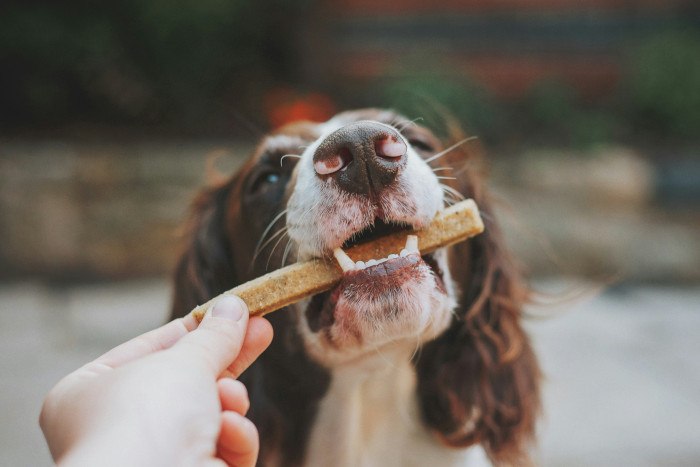More Bark for Your Buck:
A Practical Guide to Cheap and Healthy Dog Treats

As a reward-based dog trainer and behavior consultant, I use a ridiculous amount of treats in any given week for training. Prepackaged, store-bought treats are convenient but often expensive.
As holistic pet care gains momentum, more dog owners are questioning the ingredients in commercial dog food and treats. Many store-bought treats are loaded with artificial preservatives, colors, and fillers. Using fresh food for training is healthier for your dog and more affordable.
High Value. Whether it’s shredded chicken or cubed beef, most dogs go crazy for plain meat. Ditch the Charlie Bear treats (basically the Saltines of dog treats) and go for plain, unsalted meat.
No Artificial Additives. Commercial treats may contain artificial additives, such as artificial flavors, colors, and preservatives, which could trigger allergies or sensitivities in some dogs. Real food treats eliminate this concern, reducing the risk of adverse reactions and promoting better digestion.
Weight Management. Since you control the ingredients, real food treats can be tailored to your dog's dietary needs.
Dental Health. Some real food treats, such as raw carrots or apple slices, can act as natural teeth cleaners, helping to reduce plaque and tartar buildup.
Cost Effectiveness. One of the most compelling reasons to switch to real food treats is the impact on your wallet. Ingredients used in real food treats are readily available, and buying in bulk can further reduce the financial burden of keeping your treat bag full.
Consult your veterinarian. Before making any changes to your dog's diet, it's advisable to check with your veterinarian. They can help you identify any potential dietary restrictions or allergies your dog might have, ensuring that the treats you offer are safe and beneficial.
Monitor portion control. While real food treats offer numerous benefits, moderation is key. Most dogs will happily work for a piece of meat no larger than your pinky fingernail for training purposes. Halve that if you have a small dog.
Use only safe and healthy ingredients. Meats like chicken and beef are easy to find at the grocery store, and vegetables like carrots and sweet potatoes make excellent choices for real food treats. Blueberries also make great training treats.
Store properly. When not in use, store your treat pouch in the fridge. Cubed meat can be frozen in baggies until ready to use. A plastic ziplock bag lining your treat pouch will keep it from getting slimy.
If you have the time and the inclination to turn on the oven and mix a few ingredients, a quick internet search can yield a plethora of simple and delicious homemade dog treat recipes. Experiment with different combinations of ingredients to find what your dog enjoys most. Here is a step-by-step video of my favorite homemade treat recipe, which makes 500 treats for under five dollars!
Using real food for treats and training is a budget-friendly way to contribute to a healthier, happier pup. So the next time you’re tempted to reach for a store-bought treat, consider the many advantages of choosing real food treats instead. Your dog will thank you.
Not all foods are safe for dogs. Here are some common foods that can be dangerous for your dogs to ingest, but this is not an exhaustive list.
- Chocolate contains theobromine and caffeine, which can lead to vomiting, diarrhea, rapid heart rate, seizures, and even death.
- Grapes and raisins can cause kidney failure in some dogs, leading to symptoms like vomiting, lethargy, and decreased appetite.
- Onions and garlic can damage a dog's red blood cells and lead to anemia. They're often found in various forms, including powders and cooked dishes.
- Xylitol is a sugar substitute found in sugar-free gum, candy, and some baked goods. It can cause a rapid release of insulin in dogs, leading to hypoglycemia (low blood sugar), seizures, and liver failure.
- Avocado contains a substance called persin, which can be toxic to dogs and lead to vomiting and diarrhea.
- Alcohol, even in small amounts, can cause alcohol poisoning in dogs, leading to symptoms like vomiting, diarrhea, difficulty breathing, and even death.
- Caffeine is found in coffee, tea, energy drinks, and some medications. Like chocolate, caffeine can cause various symptoms, including restlessness, rapid breathing, heart palpitations, and tremors.
- Macadamia nuts are particularly toxic to dogs. Even a small amount can cause symptoms such as weakness, vomiting, tremors, elevated body temperature, and even paralysis.
- Walnuts, while not considered as toxic as macadamia nuts, can still cause gastrointestinal upset and potential blockages in a dog's digestive system due to their high-fat content.
- Pecans contain a toxin called juglone, which can lead to digestive issues and other symptoms in dogs if ingested. In general, nuts are high in fat, which can be difficult for dogs to digest and may lead to pancreatitis, a painful inflammation of the pancreas.
- High-fat foods like fatty cuts of meat, fried foods, and certain dairy products can lead to pancreatitis, a painful inflammation of the pancreas.

